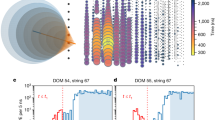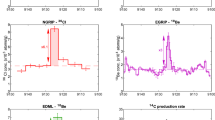Abstract
Neutrinos interact only very weakly, so they are extremely penetrating. The theoretical neutrino–nucleon interaction cross-section, however, increases with increasing neutrino energy, and neutrinos with energies above 40 teraelectronvolts (TeV) are expected to be absorbed as they pass through the Earth. Experimentally, the cross-section has been determined only at the relatively low energies (below 0.4 TeV) that are available at neutrino beams from accelerators1,2. Here we report a measurement of neutrino absorption by the Earth using a sample of 10,784 energetic upward-going neutrino-induced muons. The flux of high-energy neutrinos transiting long paths through the Earth is attenuated compared to a reference sample that follows shorter trajectories. Using a fit to the two-dimensional distribution of muon energy and zenith angle, we determine the neutrino–nucleon interaction cross-section for neutrino energies 6.3–980 TeV, more than an order of magnitude higher than previous measurements. The measured cross-section is about 1.3 times the prediction of the standard model3, consistent with the expectations for charged- and neutral-current interactions. We do not observe a large increase in the cross-section with neutrino energy, in contrast with the predictions of some theoretical models, including those invoking more compact spatial dimensions4 or the production of leptoquarks5. This cross-section measurement can be used to set limits on the existence of some hypothesized beyond-standard-model particles, including leptoquarks.
This is a preview of subscription content, access via your institution
Access options
Access Nature and 54 other Nature Portfolio journals
Get Nature+, our best-value online-access subscription
$29.99 / 30 days
cancel any time
Subscribe to this journal
Receive 51 print issues and online access
$199.00 per year
only $3.90 per issue
Buy this article
- Purchase on Springer Link
- Instant access to full article PDF
Prices may be subject to local taxes which are calculated during checkout



Similar content being viewed by others
Change history
14 February 2018
Change history: Please see accompanying Erratum (http://doi.org/10.1038/nature25472). In this Letter, ‘HERA’ was wrongly expanded to ‘Hydrogen Epoch of Reionization Array’ instead of ‘Hadron-Electron Ring Accelerator’ on page 597. In addition, some author affiliations were wrongly assigned. The original Letter has been corrected online.
References
Olive, K. A. et al. Review of particle physics. Chin. Phys. C 38, 090001 (2014)
Formaggio, J. A. & Zeller, G. P. From eV to EeV: neutrino cross sections across energy scales. Rev. Mod. Phys. 84, 1307–1341 (2012)
Cooper-Sarkar, A., Mertsch, P. & Sarkar, S. The high energy neutrino cross-section in the Standard Model and its uncertainty. J. High Energy Phys. 2011, 42 (2011)
Alvarez-Muñiz, J., Feng, J. L., Halzen, F., Han, T. & Hooper, D. Detecting microscopic black holes with neutrino telescopes. Phys. Rev. D 65, 124015 (2002)
Romero, I. & Sampayo, O. A. Leptoquarks signals in KM3 neutrino telescopes. J. High Energy Phys. 2009, 111 (2009)
Sutton, C. Spaceship Neutrino (Cambridge Univ. Press, 1992)
Connolly, A., Thorne, R. S. & Waters, D. Calculation of high energy neutrino–nucleon cross sections and uncertainties using the Martin–Stirling–Thorne–Watt parton distribution functions and implications for future experiments. Phys. Rev. D 83, 113009 (2011)
IceCube Collaboration. A combined maximum-likelihood analysis of the high-energy astrophysical neutrino flux measured with IceCube. Astrophys. J. 809, 98 (2015)
Miarecki, S. C. Earth versus Neutrinos: Measuring the Total Muon-Neutrino-to-Nucleon Cross Section at Ultra-high Energies through Differential Earth Absorption of Muon Neutrinos from Cosmic Rays using the IceCube Detector. PhD thesis, Univ. California, Berkeley https://docushare.icecube.wisc.edu/dsweb/Get/Document-78967/dissertation_Miarecki_2016.pdf (2016)
Volkova, L. V. & Zatsepin, G. T. Passage of neutrinos through the Earth. Bull. Acad. Sci. USSR Phys. Ser. 38, 151–154 (1974); translated from Izv. Akad. Nauk SSSR, Ser. fiz. 38, 1060–1063 (1974)
Wilson, T. L. Neutrino tomography: tevatron mapping versus the neutrino sky. Nature 309, 38–42 (1984)
Dziewonski, A. M. & Anderson, D. L. Preliminary reference Earth model. Phys. Earth Planet. Inter. 25, 297–356 (1981)
Kennett, B. L. N. On the density distribution within the Earth. Geophys. J. Int. 132, 374–382 (1998)
Masters, G. & Gubbins, D. On the resolution of density within the Earth. Phys. Earth Planet. Inter. 140, 159–167 (2003)
de Wit, R. W. L., Käufl, P. J., Valentine, A. P. & Trampert, J. Bayesian inversion of free oscillations for Earth’s radial (an)elastic structure. Phys. Earth Planet. Inter. 237, 1–17 (2014)
Dumand Collaboration. Mapping the Earth’s interior with astrophysical neutrinos. In 24th International Cosmic Ray Conference Vol. 1 (eds Iucci, N. & Lamanna, E. ) 804–807 http://adsabs.harvard.edu/full/1995ICRC....1..804D (IUPAP, 1995)
Gonzalez-Garcia, M. C., Halzen, F., Maltoni, M. & Tanaka, H. K. M. Radiography of Earth’s core and mantle with atmospheric neutrinos. Phys. Rev. Lett. 100, 061802 (2008)
IceCube Collaboration. The IceCube neutrino observatory: instrumentation and online systems. J. Instrum. 12, P03012 (2017)
Halzen, F. & Klein, S. R. IceCube: an instrument for neutrino astronomy. Rev. Sci. Instrum. 81, 081101 (2010)
IceCube Collaboration. The IceCube data acquisition system: signal capture, digitization, and timestamping. Nucl. Instrum. Meth. A 601, 294–316 (2009)
IceCube Collaboration. Evidence for astrophysical muon neutrinos from the northern sky with IceCube. Phys. Rev. Lett. 115, 081102 (2015)
Weaver, C. Evidence for Astrophysical Muon Neutrinos from the Northern Sky. PhD thesis, Univ. Wisconsin https://docushare.icecube.wisc.edu/dsweb/Get/Document-73829/weaver_thesis_2015.pdf (2015)
IceCube Collaboration. An improved method for measuring muon energy using the truncated mean of dE/dx. Nucl. Instrum. Meth. A 703, 190–198 (2013)
MINERvA Collaboration. Measurement of partonic nuclear effects in deep-inelastic neutrino scattering using MINERvA. Phys. Rev. D 93, 071101 (2016)
WA25 and WA59 Collaborations. An investigation of the EMC effect using anti-neutrinos interactions in deuterium and neon. Phys. Lett. 141, 133–139 (1984)
Eskola, K. J., Paakkinen, P., Paukkunen, H. & Salgado, C. A. EPPS16: nuclear parton distributions with LHC data. Eur. Phys. J. C 77, 163 (2017)
Honda, M., Kajita, T., Kasahara, K., Midorikawa, S. & Sanuki, T. Calculation of atmospheric neutrino flux using the interaction model calibrated with atmospheric muon data. Phys. Rev. D 75, 043006 (2007)
Enberg, R., Reno, M. H. & Sarcevic, I. High energy neutrinos from charm in astrophysical sources. Phys. Rev. D 79, 053006 (2009)
IceCube Collaboration. Observation and characterization of a cosmic muon neutrino flux from the northern hemisphere using six years of IceCube data. Astrophys. J. 833, 3 (2016)
Bhattacharya, A., Enberg, R., Reno, M. H., Sarcevic, I. & Stasto, A. Perturbative charm production and the prompt atmospheric neutrino flux in light of RHIC and LHC. J. High Energy Phys. 1506, 110 (2015)
Garzelli, M. V., Moch, S. & Sigl, G. Lepton fluxes from atmospheric charm revisited. J. High Energy Phys. 1510, 115 (2015)
Gauld, R., Rojo, J., Rottoli, L., Sarkar, S. & Talbert, J. The prompt atmospheric neutrino flux in the light of LHCb. J. High Energy Phys. 1602, 130 (2016)
IceCube-Gen2 Collaboration. IceCube-Gen2: a vision for the future of neutrino astronomy in Antarctica. Preprint at https://arxiv.org/abs/1412.5106 (2014)
KM3Net Collaboration. Letter of intent for KM3NeT 2.0. J. Phys. G 43, 084001 (2016)
ARIANNA Collaboration. A first search for cosmogenic neutrinos with the ARIANNA hexagonal radio array. Astropart. Phys. 70, 12 (2015)
ARA Collaboration. Performance of two Askaryan Radio Array stations and first results in the search for ultrahigh energy neutrinos. Phys. Rev. D 93, 082003 (2016)
Klein, S. R. & Connolly, A. Neutrino absorption in the Earth, neutrino cross-sections, and new physics. Preprint at https://arxiv.org/abs/1304.4891 (2013)
Acknowledgements
We acknowledge support from the following agencies: United States Air Force Academy, US National Science Foundation, Office of Polar Programs; US National Science Foundation, Physics Division; University of Wisconsin Alumni Research Foundation; the Grid Laboratory of Wisconsin (GLOW) grid infrastructure at the University of Wisconsin, Madison; the Open Science Grid (OSG) grid infrastructure; US Department of Energy; National Energy Research Scientific Computing Center; the Louisiana Optical Network Initiative (LONI) grid computing resources; Natural Sciences and Engineering Research Council of Canada; WestGrid and Compute/Calcul Canada; Swedish Research Council; Swedish Polar Research Secretariat; Swedish National Infrastructure for Computing (SNIC); Knut and Alice Wallenberg Foundation; German Ministry for Education and Research (BMBF); Deutsche Forschungsgemeinschaft (DFG); Helmholtz Alliance for Astroparticle Physics (HAP); Initiative and Networking Fund of the Helmholtz Association, Germany; Fund for Scientific Research (FNRS-FWO), FWO Odysseus programme, Flanders Institute to encourage scientific and technological research in industry (IWT), Belgian Federal Science Policy Office (BELSPO); Marsden Fund; Australian Research Council; Japan Society for Promotion of Science (JSPS); Swiss National Science Foundation (SNSF); National Research Foundation of Korea (NRF); Villum Fonden, Danish National Research Foundation (DNRF).
Author information
Authors and Affiliations
Consortia
Contributions
The IceCube neutrino observatory was designed and constructed by the IceCube Collaboration and the IceCube Project, which continues to operate it. Data processing and calibration, Monte Carlo simulations of the detector and of theoretical models, and data analyses were performed by a large number of IceCube Collaboration members, who also discussed and approved the scientific results. The analysis presented here was performed by S.Mi. with input from G.B. The paper was written by S.Mi., G.B. and S.R.K. and reviewed by the collaboration. All authors approved the final version of the manuscript.
Corresponding author
Ethics declarations
Competing interests
The author declare no competing financial interests.
Additional information
Reviewer Information Nature thanks A. De Gouvea and the other anonymous reviewer(s) for their contribution to the peer review of this work.
Publisher's note: Springer Nature remains neutral with regard to jurisdictional claims in published maps and institutional affiliations.
Rights and permissions
About this article
Cite this article
The IceCube Collaboration. Measurement of the multi-TeV neutrino interaction cross-section with IceCube using Earth absorption. Nature 551, 596–600 (2017). https://doi.org/10.1038/nature24459
Received:
Accepted:
Published:
Issue Date:
DOI: https://doi.org/10.1038/nature24459
This article is cited by
-
Search for decoherence from quantum gravity with atmospheric neutrinos
Nature Physics (2024)
-
Present and future constraints on flavor-dependent long-range interactions of high-energy astrophysical neutrinos
Journal of High Energy Physics (2023)
-
Forward production of prompt neutrinos from charm in the atmosphere and at high energy colliders
Journal of High Energy Physics (2023)
-
Locating the core-mantle boundary using oscillations of atmospheric neutrinos
Journal of High Energy Physics (2023)
-
Radiography using cosmic-ray electromagnetic showers and its application in hydrology
Scientific Reports (2022)
Comments
By submitting a comment you agree to abide by our Terms and Community Guidelines. If you find something abusive or that does not comply with our terms or guidelines please flag it as inappropriate.



